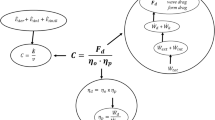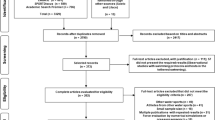Abstract
The energy cost to swim a unit distance (C sw) is given by the ratio \( \dot{E}/v \) where \( \dot{E} \) is the net metabolic power and v is the swimming speed. The contribution of the aerobic and anaerobic energy sources to \( \dot{E} \) in swimming competitions is independent of swimming style, gender or skill and depends essentially upon the duration of the exercise. C sw is essentially determined by the hydrodynamic resistance (W d): the higher W d the higher C sw; and by the propelling efficiency (η P): the higher η P the lower C sw. Hence, all factors influencing W d and/or η P result in proportional changes in C sw. Maximal metabolic power \( (\dot{E}_{\max } ) \) and C sw are the main determinants of swimming performance; an improvement in a subject’s best performance time can more easily be obtained by a reduction of C sw rather than by an (equal) increase in \( \dot{E}_{\max } \) (in either of its components, aerobic or anaerobic). These sentences, which constitute a significant contribution to today’s knowledge about swimming energetics, are based on the studies that Professor Pietro Enrico di Prampero and his co-workers carried out since the 1970s. This paper is devoted to examine how this body of work helped to improve our understanding of this fascinating mode of locomotion.







Similar content being viewed by others
References
Adrian MJ, Sing M, Karpovich PV (1966) Energy cost of leg kick, arm stroke, and whole body crawl. J Appl Physiol 21:1763–1766
Alexander R McN (1977) Swimming. In: Alexander R McN, Goldspink G (eds) Mechanics and energetics of animal locomotion. Chapman and Hall, London, pp 222–248
Capelli C (1999) Physiological determinants of best performances in human locomotion. Eur J Appl Physiol 80:298–307
Capelli C, Donatelli C, Moia C, Valier C, Rosa G, di Prampero PE (1990) Energy cost and efficiency of sculling a Venetian gondola. Eur J Appl Physiol 60:175–178
Capelli C, Zamparo P, Cigalotto A, Francescano MP, Soule RG, Termin B, Pendergast DR, di Prampero PE (1995) Bioenergetics and biomechanics of front crawl swimming. J Appl Physiol 78:674–679
Capelli C, Termin B, Pendergast DR (1998a) Energetics of swimming at maximal speed in humans. Eur J Appl Physiol 78:385–393
Capelli C, Schena F, Zamparo P, Dal Monte A, Faina M, di Prampero PE (1998b) Energetics of best performances in track cycling. Med Sci Sports Exerc 30:614–624
Capelli C, Tarperi C, Schena F, Cevese A (2009) Energy cost and efficiency of Venetian rowing on a traditional flat hull boat (Bissa). Eur J Appl Physiol 105:653–661
Cavagna GA, Kaneko M (1977) Mechanical work and efficiency in level walking and running. J Physiol (Lond) 268:467–481
Celentano F, Cortili G, di Prampero PE, Cerretelli P (1974) Mechanical aspects of rowing. J Appl Physiol 36:642–647
Chatard JC, Lavoie JM, Lacour JR (1990) Analysis of determinants of swimming economy in front crawl. Eur J Appl Physiol 61:88–92
Chatard JC, Lavoie JM, Lacour JR (1991) Energy cost of front crawl swimming in women. Eur J Appl Physiol 63:12–16
Craig AB Jr, Pendergast DR (1979) Relationships of stroke rate, distance per stroke and velocity in competitive swimming. Med Sci Sports Exer 11:278–283
Daniel TL (1991) Efficiency in aquatic locomotion: limitations from single cells to animals. In: Blake RW (ed) Efficiency and Economy in Animal Physiology. Cambridge University Press, Cambridge, pp 83–96
di Prampero PE (1981) Energetics of muscular exercise. Rev Physiol Biochem Pharmacol 89:143–222
di Prampero PE (1986) The energy cost of human locomotion on land and in water. Int J Sports Med 7:55–72
di Prampero PE (2003) Factors limiting maximal performance in humans. Eur J Appl Physiol 90:420–429
di Prampero PE, Ferretti G (1999) The energetics of anaerobic muscle metabolism: a reappraisal of old and recent concepts. Resp Physiol 118:103–115
di Prampero PE, Cortili G, Celentano F, Cerretelli P (1971) Physiological aspects of rowing. J Appl Physiol 31:853–857
di Prampero PE, Pendergast DR, Wilson D, Rennie DW (1974) Energetics of swimming in man. J Appl Physiol 37:1–5
di Prampero PE, Pendergast DR, Wilson DR, Rennie DW (1978) Blood lactic acid concentrations in high velocity swimming. In: Eriksson B, Furberg B (eds) Swimming Medicine IV. University Park Press, Baltimore, pp 249–261
di Prampero PE, Capelli C, Pagliaro P, Antonutto G, Girardis M, Zamparo P (1993) Energetics of best performance in middle distance running. J Appl Physiol 74:2318–2324
Faulkner J (1968) Physiology of swimming and diving. In: Falls HB (ed) Exercise Physiology. Academic Press, New York, pp 415–446
Havriluk R (2007) Variability in measurements of swimming forces: a meta-analysis of passive and active drag. Res Q Exerc Sport 78:32–39
Holmér I (1972) Oxygen uptake during swimming in man. J Appl Physiol 33:502–509
Holmér I (1974) Energy cost of arm stroke, leg kick and the whole stroke in competitive swimming styles. Eur J Appl Physiol 33:105–118
Karpovich PV (1933) Water resistance in swimming. Res Quart 4:21–28
Karpovich PV, Pestrecov K (1939) Mechanical work and efficiency in swimming crawl and back strokes. Arbeitsphysiologie 10:504–514
Kjendlie PL, Stallman RK, Gunderson JS (2004a) Passive and active floating torque during swimming. Eur J Appl Physiol 93:75–81
Kjendlie PL, Ingjer F, Madsen O, Stallman RK, Gunderson JS (2004b) Differences in the energy cost between children and adults during front crawl swimming. Eur J Appl Physiol 9:473–480
Kolmogorov SV, Duplisheva OA (1992) Active drag, useful mechanical power output and hydrodynamic force coefficient in different swimming strokes at maximal velocity. J Biomech 25:311–318
Margaria R, Aghemo P, Sassi G (1971) Lactic acid production in supramaximal exercise. Pfluugers Arch 362:152–161
Martin RB, Yeater RA, White MK (1981) A simple analytical model for the crawl stroke. J Biomech 14:539–548
Minetti AE (2004) Passive tools for enhancing muscle-driven motion and locomotion. J Exp Biol 207:1265–1272
Montpetit RR, Lavoie JM, Cazorla GA (1983) Aerobic energy cost of swimming the front crawl at high velocity in international class and adolescent swimmers. In: Hollander AP, Huijing PA, de Groot G (eds) Biomechanics and medicine in swimming. Human Kinetics, Champaign, pp 228–234
Montpetit R, Cazorla G, Lavoie JM (1988) Energy expenditure during front crawl swimming: a comparison between males and females. In: Ungherechts BE, Wilke K, Reischle K (eds) Swimming Science V. Human Kinetics, Champaign, pp 229–236
Pendergast DR, Craig AB Jr (1974) Biomechanics of flotation in water. Physiologist 17:305
Pendergast DR, di Prampero PE, Craig AB Jr, Wilson DR, Rennie DW (1977) Quantitative analysis of the front crawl in men and women. J Appl Physiol 43:475–479
Pendergast DR, Bushnell D, Wilson DR, Cerretelli P (1989) Energetics of kayaking. Eur J Appl Physiol 59:342–350
Pendergast DR, Mollendorf J, Zamparo P, Termin AB, Bushnell D, Paschke D (2005) The influence of drag on human locomotion in water. Undersea Hyperb Med 32:45–57
Poujade B, Hautier CA, Rouard A (2002) Determinants of the energy cost of front crawl swimming in children. Eur J Appl Physiol 87:1–6
Rossiter HB, Ward SA, Kowalchuk JM, Howe FA, Griffiths FA, Whipp BJ (2002) Dynamic asymmetry of phosphocreatine concentration and O2 uptake between the on- and off-transients of moderate and high-intensity exercise in humans. J Physiol 541:991–1002
Saltin B (1973) Oxygen transport by the circulatory system during exercise in man. In: Keul J (ed) Limiting factors of physical performance. Thieme, Stuttgard, pp 235–252
Termin B, Pendergast DR (2000) Training using the stroke frequency-velocity relationship to combine biomechanical and metabolic paradigms. J Swim Res 14:9–17
Toussaint HM (1990) Differences in propelling efficiency between competitive and triathlon swimmers. Med Sci Sports Exerc 22:409–415
Toussaint HM, Beleen A, Rodenburg A, Sargeant AJ, De Groot G, Hollander AP, van Ingen Schenau GJ (1988) Propelling efficiency of front crawl swimming. J Appl Physiol 65:2506–2512
Toussaint HM, Knops W, De Groot G, Hollander AP (1990) The mechanical efficiency of front crawl swimming. Med Sci Sports Exerc 22:408–402
Toussaint HM, Janssen T, Kluft M (1991) Effect of propelling surface size on the mechanics and energetics of front crawl swimming. J Biomech 24:205–211
Toussaint HM, Hollander AP, van den Berg C, Vorontsov AR (2000) Biomechanics of swimming. In: Garrett W, Kirkendall DT (eds) Exercise and Sport Science. Lippincott Williams and Wilkins, Philadelphia, pp 639–659
Toussaint HM, Roos PE, Kolmogorov S (2004) The determination of drag in front crawl swimming. J Biomech 37:1655–1663
Wilkie DR (1980) Equations describing power input by humans as a function of duration of exercise. In: Cerretelli P, Whipp BJ (eds) Exercise bioenergetics and gas exchange. Elsevier, Amsterdam, pp 75–80
Wilson B, Thorp R (2003) Active drag in swimming. In: Chatard JC (ed) Biomechanics and Medicine in Swimming IX. Publications de l’Université de Saint Etienne, Saint Etienne, France, pp 15–20
Zamparo P (2006) Effects of age and gender on the propelling efficiency of the arm stroke. Eur J Appl Physiol 97:52–58
Zamparo P, Capelli C, Termin AB, Pendergast DR, di Prampero PE (1996a) The effect of the underwater torque on the energy cost, drag and efficiency of front crawl swimming. Eur J Appl Physiol 73:195–201
Zamparo P, Antonutto G, Capelli C, Francescato MP, Girardis M, Sangoi R, Soule RG, Pendergast DR (1996b) Effects of body size, body density, gender and growth on underwater torque. Scand J Med Sci Sports 6:273–280
Zamparo P, Capelli C, Guerrini G (1999) Energetics of kayaking at sub-maximal and maximal speeds. Eur J Appl Physiol 80:542–548
Zamparo P, Capelli C, Cautero M, Di Nino A (2000) Energy cost of front crawl swimming at supramaximal speeds and underwater torque in young swimmers. Eur J Appl Physiol 83:487–491
Zamparo P, Pendergast DR, Termin AB, Minetti AE (2002) How fins affect the economy and efficiency of human swimming. J Exp Biol 205:2665–2676
Zamparo P, Pendergast DR, Mollendorf J, Termin A, Minetti AE (2005a) An energy balance of front crawl. Eur J Appl Physiol 94:134–144
Zamparo P, Bonifazi M, Faina M, Milan A, Sardella F, Schena F, Capelli C (2005b) The energy cost of swimming in elite long distance swimmers. Eur J Appl Physiol 94:697–704
Zamparo P, Tomadini S, Di Donè F, Grazzina F, Rejc E, Capelli C (2006) Bioenergetics of a slalom kayak (K1) competition. Int J Sports Med 27:546–552
Zamparo P, Carignani G, Plaino L, Sgalmuzzo B, Capelli C (2008a) Energetics of locomotion with pedal driven watercrafts. J Sport Sci 26:75–81
Zamparo P, Lazzer S, Antoniazzi C, Cedolin S, Avon R, Lesa C (2008b) The interplay between propelling efficiency, hydrodynamic position and energy cost of front crawl in 8 to 19-year-old swimmers. Eur J Appl Physiol 104:689–699
Zamparo P, Gatta G, Capelli C, Pendergast DR (2009) Active and passive drag, the role of trunk incline. Eur J Appl Physiol 106:195–205
Author information
Authors and Affiliations
Corresponding author
Additional information
Communicated by Susan Ward.
This article is published as part of the Special Issue dedicated to Pietro di Prampero, formerly Editor-in-Chief of EJAP.
Rights and permissions
About this article
Cite this article
Zamparo, P., Capelli, C. & Pendergast, D. Energetics of swimming: a historical perspective. Eur J Appl Physiol 111, 367–378 (2011). https://doi.org/10.1007/s00421-010-1433-7
Accepted:
Published:
Issue Date:
DOI: https://doi.org/10.1007/s00421-010-1433-7




